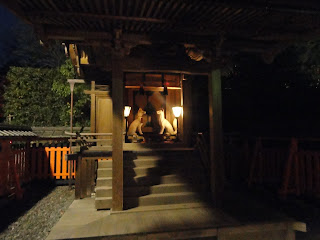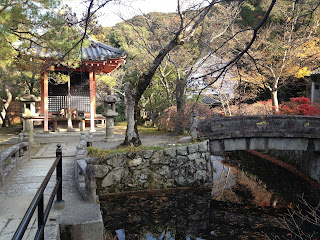Kyoto is an old city having celebrated its 1200-year anniversary of its founding back in 1994 and is one of the few major metropolitan areas to escape the wrath of American bombing in World War Two. We are fortunate that it did. The city is full of old temples and shrines, beautiful gardens, formidable castles of the shoguns, mysterious imperial palaces, quaint and interesting shops, fantastic restaurants, and since the city is surrounded on three sides by mountains, a plethora of trails.
We stayed in a small ryokan, a traditional Japanese-style bed and breakfast, which the owners have run for 40+ years. While sleeping on a futon was a bit of a challenge for a person used to beds like T and the lack of a bathroom and shower in the room was a minor inconvenience, the large Japanese-style breakfast was amazing and the mother and daughter hosts were welcoming and helpful.
Breakfast ryokan-style.
Beds ryokan-style.
Our first stop was the Fushimi-Inari-Taisha Shinto shrine, which was one of the most visually interesting of the many shrines we viewed. It sits at the base of a mountain and thousands of red torii (shrine gates) line the paths stretching up the slopes to the rear of the complex. Dozens of stone foxes adorn the shrine. They are considered the messengers of Inari, the god of cereals, and the key seen in their mouths is for the rice granary. According to Japanese folklore, the fox is a mysterious figure capable of possessing humans, usually entering under the fingernails. The grounds are also home to dozens of graveyards and individual shrines. Since it was only a few blocks from our ryokan, we made two visits here, one our first night and the other on the last day.
If anyone can explain the meaning of the red bibs to H, she would be grateful.
Strings of tsuru, folded origami cranes, line the shrine walls and also give H the heebie-jeebies. For those who don't know the story, Japanese tradition (especially that of Hawaii's Japanese) requires brides to fold 1001 cranes and for the finished work to be displayed at the wedding. This is to reassure family and friends that the bride has sufficient perseverance, diligence and patience to make the marriage successful. The groom of course has nothing to prove. Instead of the traditional ropes of cranes, H decided to scatter them across our wedding and reception site (T's parents home place).
His Mom picked cranes out of her flower beds for months after.
Our next major stop was Kyomizu-Dera, a Buddhist temple sitting on a commanding position above the city. The temple was first established in 798, although the current structures date from the 1600s. Lonely Planet calls it Kyoto's "spiritual heart and soul." We would agree that it is an impressive structure, with lovely buildings, fascinating architecture, beautiful grounds, and great view, but the crowds took some of the spiritual nature of the visit away. The street leading up the temple was packed with tourists, small shops, and restaurants. The grounds too were loaded with tourists like us, plus tons of giddy Japanese teenagers there to buy a prayer plaque to assure success in romance and others sipping from the Otowa-no-taki spring where the waters are supposed to bestow health and long life.
Random rabbit dude at Kiyomizu-Dera. Made T think of the character Hazel from Richard Adam's classic Watership Down.
From Kiyomizu-Dera, we walked the streets along the base of the Higashiyama (Eastern Mountains), taking in the sites, including young ladies dressed in traditional clothing, monuments to fallen soldiers and the guardian of their cemetery, rickshaws pulled by young men (boy, were those guys impressive!), massive temples, secluded "urban" gardens, burial sites for long-dead emperors, and ancient moss-covered trees.
H in heaven at a store devoted to her personal good luck charm, Totoro.
A real tsuru in a random pond in a random garden.
Oni (ogres) dot the rooftops.
Some Emperor's resting place.
For lunch we stopped at a bento (boxed lunch) hole in the wall. It was the first time H has had a bento made to order and it was delicious.
The final temple stop was the grand Ginkaku-ji (Silver Pavilion). Although the grounds were indeed lovely, H was crestfallen when she realized that the Silver Pavilion isn't silver at all. In a way, it like much of the trip for her ... realizing how little she understands about her own culture.
Our first day in Kyoto ended with an evening spent in Gion, the entertainment district of the city. Lonely Planet describes it as a bit drab during the day, but it was certainly a lively place at night, well-lit and full of people. Indeed, many of the restaurants were full, but we managed to find a couple of nice places along some of the numerous alleyways to enjoy a drink and a sampling of the local cuisine.
Our last stop was to an Izakaya restaurant. Similar to tapas bars, these are places where alcohol is the primary draw and food comes in appetizer portions. While the food was good, what really got us interested was the replacement of wait staff with small touch screen menus that transmitted our orders wirelessly. We probably ordered more than we needed to because it was so fun touching the screen and watching the food appear.
The Gion Kabuki Theater.
















































How wonderful to be able to visit such places. I am seeing them through your camera lens.
ReplyDeleteHow long did it take Heather to fold all those cranes for your wedding.
I'm glad you enjoyed it Nicola. It took about 2 1/2 weeks to fold the cranes. Towards the end it took me about 45 seconds to fold each crane.
DeleteI have been to Tokyo and Nagoya, but not Kyoto. I hope to be able to visit Japan again - I love going there. And I was not at all surprised that Japanese food is so much more delicious and varied than the so-called Japanese restaurants in the US would have you believe! Two of the most memorable meals of my life were a vegetarian kaiseki and the robatayaki at Inakaya, both in Tokyo.
ReplyDeleteThanks for the tour, once again!